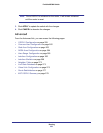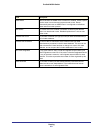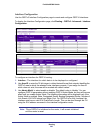
Routing
260
ProSafe M5300 Switch
OSPFv3 Configuration
1. Use Router ID to specify the 32-bit integer in dotted decimal format that uniquely
identifies the router within the autonomous system (AS). If you want to change the
Router ID you must first disable OSPFv3. After you set the new Router ID, you must
re-enable OSPFv3 to have the change take effect. The default value is 0.0.0.0, although
this is not a valid Router ID.
2. Use Admin Mode* to select enable or disable. If you select enable, OSPFv3 will be
activated for the switch. The default value is enable. You must configure a Router ID before
OSPFv3 can become operational. This can also be done by issuing the CLI command
router-id, in the IPv6 router OSPF mode.
Note: *Once OSPFv3 is initialized on the router, it will remain initialized
until the router is reset.
3. Use Exit Overflow Interval to enter the number of seconds that, after entering overflow
state, the router should wait before attempting to leave overflow state. This allows the router
to again originate non-default AS-external-LSAs. If you enter 0, the router will not leave
Overflow State until restarted. The range is 0 to 2147483647 seconds.
4. Use External LSDB Limit to specify the maximum number of AS-External-LSAs that can be
stored in the database. A value of -1 implies there is no limit on the number that can be
saved. The valid range of values is -1 to 2147483647.
5. Use Default Metric to set a default for the metric of redistributed routes. This field displays
the default metric if one has already been set or blank if not configured earlier. The valid
values are 1 to 16777214.
6. Use Maximum Paths to configure the maximum number of paths that OSPFv3 can report
to a given destination. The valid values are 1 to 4.
7. Use AutoCost Reference Bandwidth to configure the auto-cost reference-bandwidth to
control how OSPF calculates default metrics for the interface. The valid values are 1 to
4294967.
8. Use Default Passive Setting to configure the global passive mode setting for all OSPF
interfaces. Configuring this field overwrites any present interface level passive mode setting.
OSPF does not form adjacencies on passive interfaces, but does advertise attached
networks as stub networks.


















